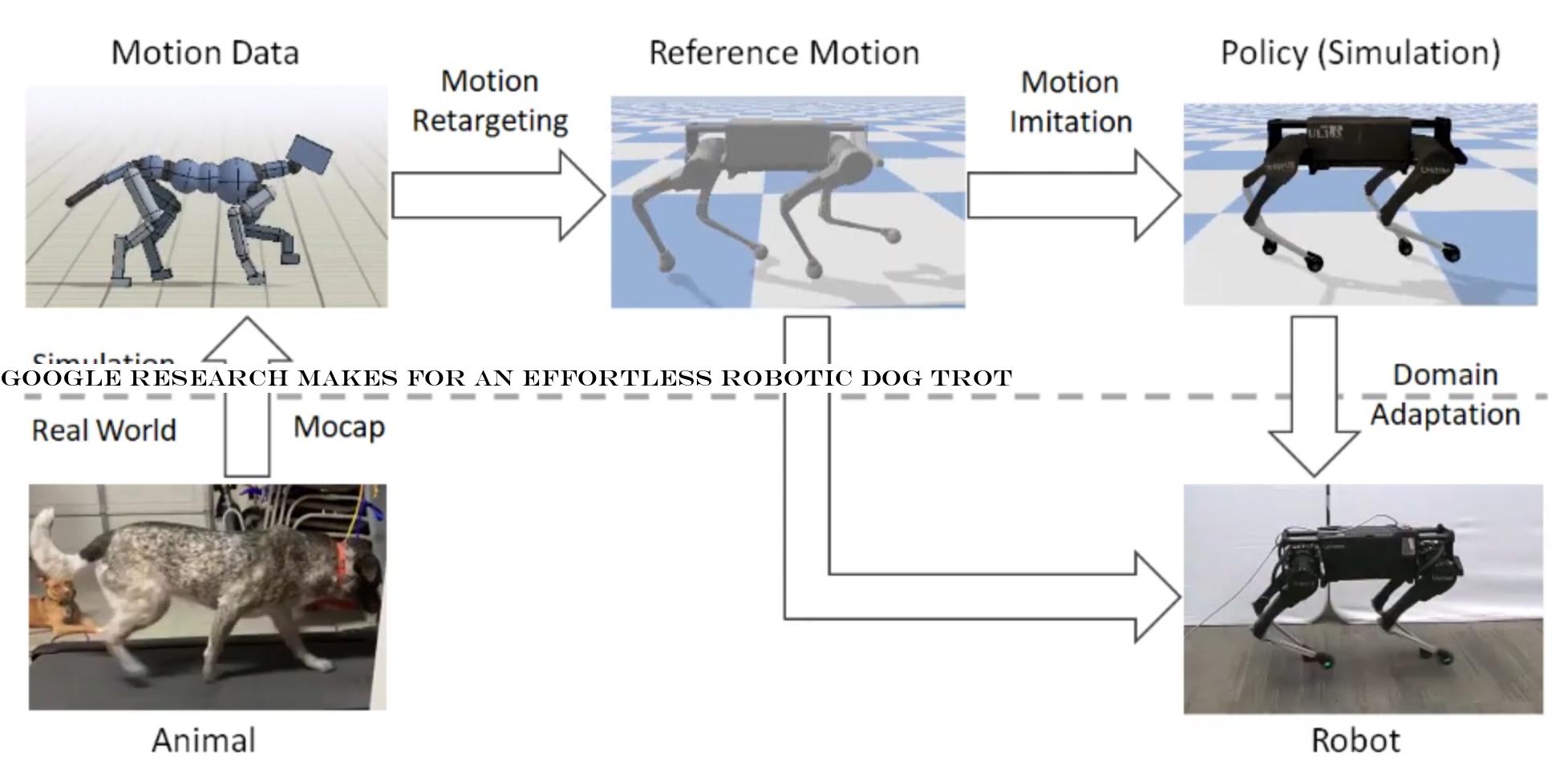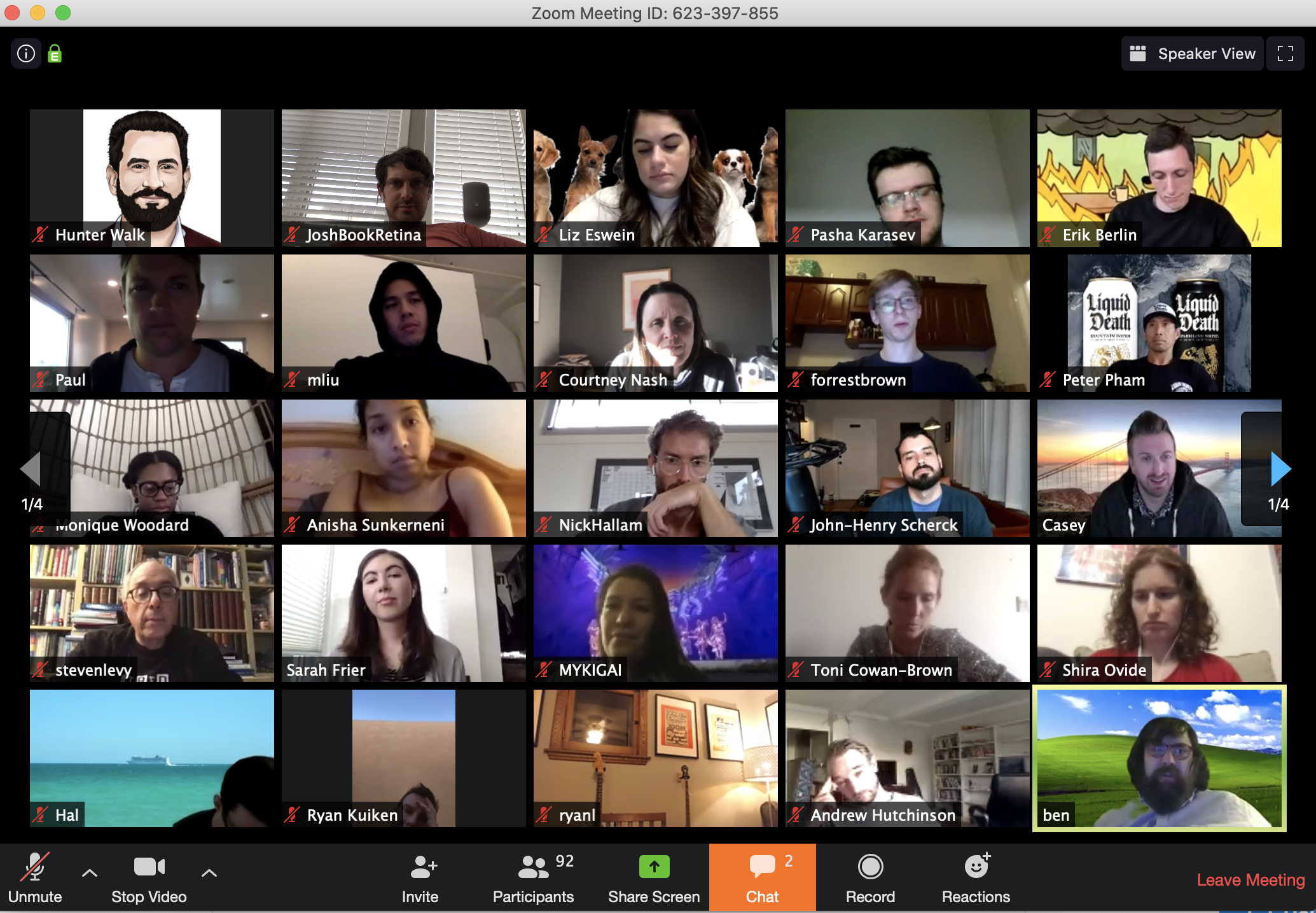Music
Trailers
DailyVideos
India
Pakistan
Afghanistan
Bangladesh
Srilanka
Nepal
Thailand
StockMarket
Business
Technology
Startup
Trending Videos
Coupons
Football
Search
Download App in Playstore
Download App
Best Collections
Technology
As capable as robots are, the original animals after which they tend to be designed are always much, much better. Thatpartly because itdifficult to learn how to walk like a dog directly from a dog — but this research from GoogleAI labs make it considerably easier.
The goal of this research, a collaboration with UC Berkeley, was to find a way to efficiently and automatically transfer &agile behaviors& like a light-footed trot or spin from their source (a good dog) to a quadrupedal robot. This sort of thing has been done before, but as the researchers& blog post points out, the established training process can often &require a great deal of expert insight, and often involves a lengthy reward tuning process for each desired skill.&
That doesn&t scale well, naturally, but that manual tuning is necessary to make sure the animalmovements are approximated well by the robot. Even a very doglike robot isn&t actually a dog, and the way a dog moves may not be exactly the way the robot should, leading the latter to fall down, lock up or otherwise fail.
 The Google AI project addresses this by adding a bit of controlled chaos to the normal order of things. Ordinarily, the dogmotions would be captured and key points like feet and joints would be carefully tracked. These points would be approximated to the robotin a digital simulation, where a virtual version of the robot attempts to imitate the motions of the dog with its own, learning as it goes.
The Google AI project addresses this by adding a bit of controlled chaos to the normal order of things. Ordinarily, the dogmotions would be captured and key points like feet and joints would be carefully tracked. These points would be approximated to the robotin a digital simulation, where a virtual version of the robot attempts to imitate the motions of the dog with its own, learning as it goes.
So far, so good, but the real problem comes when you try to use the results of that simulation to control an actual robot. The real world isn&t a 2D plane with idealized friction rules and all that. Unfortunately, that means that uncorrected simulation-based gaits tend to walk a robot right into the ground.
To prevent this, the researchers introduced an element of randomness to the physical parameters used in the simulation, making the virtual robot weigh more, or have weaker motors, or experience greater friction with the ground. This made the machine learning model describing how to walk have to account for all kinds of small variances and the complications they create down the line — and how to counteract them.
 Learning to accommodate for that randomness made the learned walking method far more robust in the real world, leading to a passable imitation of the target dog walk, and even more complicated moves like turns and spins, without any manual intervention and only a little extra virtual training.
Learning to accommodate for that randomness made the learned walking method far more robust in the real world, leading to a passable imitation of the target dog walk, and even more complicated moves like turns and spins, without any manual intervention and only a little extra virtual training.
Naturally manual tweaking could still be added to the mix if desired, but as it stands this is a large improvement over what could previously be done totally automatically.
In another research project described in the same post, another set of researchers describe a robot teaching itself to walk on its own, but imbued with the intelligence to avoid walking outside its designated area and to pick itself up when it falls. With those basic skills baked in, the robot was able to amble around its training area continuously with no human intervention, learning quite respectable locomotion skills.
The paper on learning agile behaviors from animals can be read here, while the one on robots learning to walk on their own (a collaboration with Berkeley and the Georgia Institute of Technology) is here.
- Details
- Category: Technology Today
Read more: Google research makes for an effortless robotic dog trot
Write comment (97 Comments)Zoom is making some drastic changes to prevent rampant abuse as trolls attack publicly shared video calls. Starting April 5th, it will require passwords to enter calls via Meeting ID, as these may be guessed or reused. Meanwhile, it will change virtual waiting rooms to be on by default so hosts have to manually admit attendees.
The changes could prevent &Zoombombing,& a term I coined two weeks ago to describe malicious actors entering Zoom calls and disrupting them by screensharing offensive imagery. New Zoombombing tactics have since emerged, like spamming the chat thread with terrible GIFs, using virtual backgrounds to spread hateful messages or just screaming profanities and slurs. Anonymous forums have now become breeding grounds for organized trolling efforts to raid calls.

Just imagine the most frightened look on all these peoplefaces. Thatwhat happened when Zoombombers attacked the call.
The FBI has issued a warning about the Zoombombing problem after childrenonline classes, Alcoholics Anonymous meetings and private business calls were invaded by trolls. Security researchers have revealed many ways that attackers can infiltrate a call.
The problems stem from Zoom being designed for trusted enterprise use cases rather than cocktail hours, yoga classes, roundtable discussions and classes. But with Zoom struggling to scale its infrastructure as its daily user count has shot up from 10 million to 200 million over the past month due to coronavirus shelter-in-place orders, itfound itself caught off guard.

Zoom CEO Eric Yuan apologized for the security failures this week and vowed changes. But at the time, the company merely said it would default to making screensharing host-only and keeping waiting rooms on for its K-12 education users. Clearly it determined that wasn&t sufficient, so now waiting rooms are on by default for everyone.
Zoom communicated the changes to users via an email sent this afternoon that explains &we&ve chosen to enable passwords on your meetings and turn on Waiting Rooms by default as additional security enhancements to protect your privacy.&
The company also explained that &For meetings scheduled moving forward, the meeting password can be found in the invitation. For instant meetings, the password will be displayed in the Zoom client. The password can also be found in the meeting join URL.& Some other precautions users can take include disabling file transfer, screensharing or rejoining by removed attendees.

NEW YORK, NY & APRIL 18: Zoom founder Eric Yuan reacts at the Nasdaq opening bell ceremony on April 18, 2019 in New York City. The video-conferencing software company announced itIPO priced at $36 per share, at an estimated value of $9.2 billion. (Photo by Kena Betancur/Getty Images)
The shift could cause some hassle for users. Hosts will be distracted by having to approve attendees out of the waiting room while they&re trying to lead calls. Zoom recommends users resend invites with passwords attached for Meeting ID-based calls scheduled for after April 5th. Scrambling to find passwords could make people late to calls.
But thata reasonable price to pay to keep people from being scarred by Zoombombing attacks. The rash of trolling threatened to sour many peopleearly experiences with the video chat platform just as itbeen having its breakout moment. A single call marred by disturbing pornography can leave a stronger impression than 100 peaceful ones with friends and colleagues. The old settings made sense when it was merely an enterprise product, but it needed to embrace its own change of identity as it becomes a fundamental utility for everyone.
Technologists will need to grow better at anticipating worst-case scenarios as their products go mainstream and are adapted to new use cases. Assuming everyone will have the best intentions ignores the reality of human nature. Therealways someone looking to generate a profit, score power or cause chaos from even the smallest opportunity. Building development teams that include skeptics and realists, rather than just visionary idealists, could keep ensure products get safeguarded from abuse before rather than after a scandal occurs.

- Details
- Category: Technology Today
Read more: Zoom will enable waiting rooms by default to stop Zoombombing
Write comment (97 Comments)When you look at the most successful companies on the planet, they are practically never ever just one simple service. Instead, they provide a platform with a series of services and a capability to link to it to allow external partners and developers to extend the base performance that the business supplies. Desiring be a platform and in fact prospering at building one are not the exact same. While every start-up most likely sees themselves as ending up being a platform play eventually, the truth is ithard to construct one. But if you can succeed and your set of services end up being an integral part of a given company workflow, your company might become bigger and more effective than even the most optimistic founder ever envisioned. Take a look at the biggest tech business worldwide, from Microsoft to Oracle to Facebook to Google and Amazon. All of them use a rich complex platform of services. All of them supply a way for third parties to plug in and take advantage of them in some method, even if itby using the companysheer popularity to advertise. Michael A. Cusumano, David B. Yoffie and Annabelle Gawer, who composed the book Business of Platforms, composed a post just recently in MIT Sloan Review on The Future of Platforms, stating that simply ending up being a platform doesn & t assurance success for a startup. & Because, like all companies, platforms must eventually perform better than their competitors. In addition, to endure long-term, platforms need to also be politically and socially feasible, or they run the risk of being squashed by government regulation or social opposition, as well as potentially massive financial obligation commitments, & they wrote. In other words, itnot cheap or easy to build an effective platform, however the benefits are large. As Cusumano, Yoffie and Gawer explain their research studies have actually found, & & hellip; Platform business attained their sales with half the variety of employees [of effective non-platform companies] Platform companies were twice as rewarding, were growing twice as quick, and were more than twice as important as their conventional equivalents. &. From a business point of view, look at a company like Salesforce. The business found out long back that it couldn & t perhaps build every permutation of consumer requirements with a reasonably little team of engineers (particularly early on), so it started to construct hooks into the platform it had built to permit clients and specialists to personalize it to meet the requirements of specific organizations. Eventually Salesforce constructed APIs, then it built a whole set of development tools, and developed a marketplace to share these add-ons. Some start-ups like FinancialForce, Vlocity and Veeva have actually built entire business on top of Salesforce. Rory O&D riscoll, a partner at Scale Venture Partners, speaking at a venture capitalist panel at BoxWorks in 2014, stated that numerous start-ups aspire to be platforms, but itharder than it looks. & You wear & t make a platform. Third-party developers just engage when you attain a critical mass of users. You need to do something else and then become a platform. You wear & t come totally formed as a platform, & he stated at the time. If you & re thinking, how you could perhaps start a company like that in the middle of an enormous recession, consider that Microsoft introduced in 1975 in the middle of economic crisis. Google and Salesforce both released in the late 1990s, simply ahead of the dot-com crash, and Facebook launched in 2004, four years before the massive slump in 2008. All went on to become greatly successful companies. That success often requires huge costs and sales and marketing burn, but when it works, the rewards are enormous. Simply wear & t anticipate that itan simple course to success. How Salesforce paved the way for the SaaS platform method.
- Details
- Category: Technology Today
Read more: Want to endure the downturn Better construct a platform
Write comment (92 Comments)
Stocks fell in regular trading Friday, as all major American indices fell in the wake of a broadly negative jobs report. With more than 700,000 jobs lost in the March data, unemployment in the United States rose from 3.5% to 4.4%.
The markets have been bracing for widespread job losses due to the continued fallout from COVID-19, the disease caused by coronavirus that has prompted local, county and state officials throughout the U.S. and Europe to issue stay-at-home orders. Those directives have forced bars, restaurants, gyms and other non-essentials businesses to close.
While the market had expected a wave of job losses, stocks fell as those figures surpassed expectations. Selloffs were further spurred by this troubling recognition: Fridayfigures only account for unemployment-insurance claims individuals filed in the first two weeks of March, before most of the COVID-related layoffs began.
This was unlike Thursday, when negative data led to market gains.
Here are the dayraw results:
- Dow Jones Industrial Average: down 1.67%, or 357.99 points, to close at 21,055.45
- S-P 500: fell 1.52%, or 38.34 points, to close at 2,488.56
- Nasdaq composite: declined 1.53%, or 114.23 points, to close at 7,373.08
Shares of SaaS and cloud companies tracked by the Bessemer cloud index fell as well, while cryptocurrencies were roughly flat in the 24-hour period ending with the close of equity trading.
There were standouts, however. Shares of Tesla held onto some of their after-hours gains recorded yesterday, closing the day up 5.62% to close at $408.01 as the company continued to ride its positive report that it had delivered more vehicles than expected. Bill.com, a recent SaaS IPO, managed gains as well, closing the day up 2.71%. It was somewhat hard to find exceptions to the selloff; most companies lost ground in the face of worse-than-expected economic data.
Every sector saw downward pressure Friday, with the exception of energy and consumer products, which saw a bit of a lift. Oil futures had one of its best days on record, after Russian President Vladimir Putin said global cuts of around 10 million barrels a day are possible.
Airlines were also hit Friday after the U.S. Department of Transportation ordered the industry to provide refunds on any flights that companies had canceled. While airline stocks recovered, they all closed in negative territory. United Airlines fell 2.28% to close at $22.88, American Airlines declined 6.8% to $9.38 and Delta Airlines dropped 0.88% to $22.48.
- Details
- Category: Technology Today
Read more: Stocks drop as unemployment spikes
Write comment (94 Comments)
As of this writing, nearly a million people globally have been infected with the novel coronavirus and 50,322 have died. Healthcare systems are overwhelmed, consumers and profiteers are hoarding supplies and some service workers have launched strikes while many others have been let go. In the world of micromobility, we&ve seen Bird lay off hundreds of employees and Lime is reportedly gearing up for layoffs of its own.
Ride Report creates software that enables cities to better work with micromobility operators and has a bird&s-eye view on the industry. In a conversation with TechCrunch, CEO William Henderson outlined some of the trends that have emerged and what we can expect for micromobility operators amid the pandemic — and once itover.
&All of this came at a really hard time for micromobility,& he tells TechCrunch. &It couldn&t really have occurred at a worse time in some ways.&
Thatbecause there was already a lot of pressure on startups in the space to reach profitability on an accelerated timeline, Henderson says. While winter is notoriously known as a rough time, the environment in this pandemic is µmobility winter on steroids.&
Over the last month, companies have paused operations in cities and started laying off people. Operators Bird and Lime, for example, paused operations across the board last month.
- Details
- Category: Technology Today
Read more: Pandemic puts the brakes on micromobility
Write comment (92 Comments)Since 2016, social media companies have faced an endless barrage of bad press and public criticism for failing to anticipate how their platforms could be used for dark purposes at the scale of populations — undermining democracies around the world, say, or sowing social division and even fueling genocide.
As COVID-19 plunges the world into chaos and social isolation, those same companies may face a respite from focused criticism, particularly with the industry leveraging its extraordinary resources to pitch in with COVID-19 relief efforts as the world looks to tech upstarts, adept at cutting through red tape and fast-forwarding scientific progress in normal times, while government bureaucracies lag. But the same old problems are rearing their ugly heads just the same, even if less of us are paying attention.
On YouTube, a new report from The Guardian and watchdog group Tech Transparency Project found that a batch of videos promoting fake coronavirus cures are making the company ad dollars. The videos, which promoted unscientific methods including &home remedies, meditative music, and potentially unsafe levels of over-the-counter supplements like vitamin C& as potential treatments for the virus, ran ads from unwitting advertisers including Liberty Mutual, Quibi, Trump2020 reelection campaign and Facebook. In Facebookcase, a banner ad for the company ran on a video suggesting music that promotes &cognitive positivity by using subtle yet powerful theta waves& could ward off the virus.
In the early days of the pandemic, YouTube prohibited ads on any videos related to the coronavirus. In mid-March, as the real scope of the event became clear, the company walked that policy back, allowing some channels to run ads. On Thursday, the company expanded that policy to allow ads for any videos that adhere to the companyguidelines. One of the major tenets in those guidelines forbids the promotion of medical misinformation, including &promotion of dangerous remedies or cures.& Most of the videos in the new report were removed after being flagged by a journalist.
This example, and the many others like it, calls into question how to judge major tech platforms during these exceedingly strange times. Social media companies have been uncharacteristically transparent about the shifts the pandemic is creating within their own workflows. On a call in March, Facebook founder Mark Zuckerberg admitted that, with its army of 15,000 contract moderators sent home on paid leave, users can expect more &false positives& as the company shifts to rely more heavily on artificial intelligence to filter what belongs on the platform and what does not. The work of sorting through a platformmost unsavory content — child pornography, extreme violence, hate speech and the like — is not particularly portable, given its potential psychological and legal ramifications.
YouTube similarly warned that it will &temporarily start relying more on technology& to fill in for human reviewers, warning that the automated processes will likely mean more video removals, &including some videos that may not violate policies.& Twitter noted the same new reliance on machine learning &to take a wide range of actions on potentially abusive and manipulative content,& though the company will offer an appeals process that loops in a human reviewer. Companies offered fewer warnings about what might fall through the cracks in the interim.
What will become of moderation once things return to normal, or, more likely, settle on a new normal? Will artificial intelligence have mastered the task, obviating the need for human reviewers once and for all? (Unlikely.) Will social media companies have a fresh appreciation for the value of human efforts and bring more of those jobs in-house, where they can perform their bleak work with more of the sunny perks afforded to their full-time counterparts? Like most things examined through the nightmarish haze of the pandemic, the outcomes are hazy at best.
If the approach to holding platforms to account was already piecemeal, an uneven mix of investigative reporting, anecdotal tweets and official corporate post-mortems, the truth will be even more difficult to get at now, even as the coronavirus pandemic provides countless new deadly opportunities for price-gougers and myriad bad actors to create chaos within chaos.
We&ve seen deadly consequences already in Iran, where hundreds died after drinking industrial alcohol — an idea they got &in messages forwarded and forwarded again& amplifying a tabloid story that suggested the act could protect them from the virus. Most consequences will likely go unnoticed beyond the lives they impact and unreported due to tightened newsroom resources and perhaps even more constricted attention spans.
Much has been written about the coronavirus and the fog of war, most of it rightly focused on scientific research pressing on as the virus threatens the globe and the devastating on-the-ground reality in hospitals and health facilities overwhelmed with COVID-19 patients while life-saving supplies dwindle. But the crisis of viral misinformation — and deliberately sown disinformation — is its own fog, now intermixing with an unprecedented global crisis that has entirely upended business and relentlessly dominated the news cycle. This as the worldforemost power heads into a completely upended presidential election cycle — its first since four years ago, when an unexpected election outcome coupled with deep U.S.-centrism in tech circles revealed nefarious forces at play just under the surface of the social networks we hadn&t thought all that much about.
In the present, it will be difficult for outsiders to determine where new systems implemented during the pandemic have failed and what bad outcomes would have happened anyway. To sort those causes out, we&ll have to take a companyword for it, a risky kind of credulity that already offered mixed results in normal times. Even as we rely on them now more than ever to forge and nurture connections, the virtual portals we immerse ourselves in daily remain black boxes, inscrutable as ever. And as with so many aspects of life in these norm-shattering times, the only thing to expect is change.

- Details
- Category: Technology Today
Read more: The pandemic is already reshaping tech’s misinformation crisis
Write comment (96 Comments)Page 1045 of 1420

 11
11





